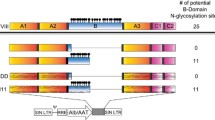Abstract
Vector Gti’IX containing human clotting factor IX cDNAwith intron 1 (hFIX mini-gene or Fi’IX) driven by CMV promoter was constructed based on the mini-adenoviral vector GT2073 (mini-Ad vector) with all viral protein coding sequences deleted. Mini-Ad packaging cell 293Cre4 was first transduced with GTi’IX, and then was transfected with helper-adenovirus AdLC8, thus mini-Ad virions AdGTi’IX were obtained. At the same time, previous normal adenoviral vector pAdSPi’IX containing viral genome and hFIX mini-gene was constructed, and then previous adenovirus (pre-Ad) AdSPi’IX was obtained as control. The ratio of helper-adenovirus among purified virons AdGTi’IX was less than 0.8%. 3T3 cells were transfected with AdGTi’IX and AdSPi’IX at a MOI of 50 per cell and ELISA result showed that transient expression level in vitro was 1.4 ±0.2 μg /106 · 24 h and 1.6 ±0.3 μg/106 · 24 h respectively. Each hemophilia B (FIX knock-out) mouse received celiac injection of 1x1010 pfu AdGTi’IX or AdSPi’IX. The highest expression level of hFIX in mouse plasma was 590 ng/mL and 690 ng/mL respectively, and the expression time lasted for 16 weeks and 9 weeks respectively. The bleeding time reduced from over 30 min to 7.5 min, and 5-min blood lost reduced from 430 μL to 60 μL. The results of anti-Ad IgG assays indicated that immune response triggered by AdGTi’IX was obviously weaker than that triggered by AdSPi’IX. These results indicated that, compared with previous adenovirus (pre-Ad), the mini-Ad vector system prolonged the expression time of hFIX and reduced immune response, thus offering a promising result for further pre-clinical study.
Similar content being viewed by others
References
Wang, Q., Lu, D. R., Xing, Y. N. et al., Establishment of the recombinant adenovirus-mediated gene transfer system and expression of hFIX in vivo and in vitro, Journal of Fudan University (Natural Science), 1996, 35: 601–606.
Graham, F. L., Smiley, J., Russell, W. C. et al., Characteristics of a human cell line transformed by DNA from human adenovirus type 5, J. Gen. Virol., 1977, 36(1): 59–74.
Fisher, K. J., Choi, H., Burda, J. et al., Recombinant adenovirus deleted of all viral genes for gene therapy of cystic fibrosis, Virology, 1996, 217(1): 11–22.
Wang, H. W., Zheng, B., Xue, J. L. et al., Expression of human clotting factor IX with EBV shuttle vector, Chinese Sci. Bull., 1995, 40(21): 1829–1833.
Kung, S. H., Hagstrom, J. N., Cass, D. et al., Human factor IX corrects the bleeding diathesis of mice with hemophilia B, Blood, 1998, 91(3): 784–790.
Chirmule, N., Propert, K., Magosin, S. et al., Immune responses to adenovirus and adeno-associated virus in humans, Gene Ther., 1999, 6(9): 1574–1583.
Krougliak, V., Graham, F. L., Development of cell lines capable of complementing E1, E4, and protein IX defective adenovirus type 5 mutants, Hum. Gene Ther., 1995, 6(12): 1575–1586.
Lee, M. G., Abina, M. A., Haddada, H. et al., The constitutive expression of the immunomodulatory gp19k protein in E1-, E3-adenoviral vectors strongly reduces the host cytotoxic T cell response against the vector, Gene Ther., 1995, 2(4): 256–262.
Amalfitano, A., Hauser, M. A., Hu, H. et al., Production and characterization of improved adenovirus vectors with the E1, E2b, and E3 genes deleted, J. Virol., 1998, 72(2): 926–933.
Gao, G. P., Yang, Y., Wilson, J. M., Biology of adenovirus vectors with E1 and E4 deletions for liver-directed gene therapy, J. Virol., 1996, 70(12): 8934–8943.
Wang, Q., Greenburg, G., Bunch, D. et al., Persistent transgene expression in mouse liver following in vivo gene transfer with a delta E1/delta E4 adenovirus vector, Gene Ther., 1997, 4(5): 393–400.
Parks, R. J., Chen, L., Anton, M. et al., A helper-dependent adenovirus vector system: Removal of helper virus by Cre-mediated excision of the viral packaging signal, Proc. Natl. Acad. Sci. USA, 1996, 93(24): 13565–13570.
Benihoud, K., Yeh, P., Perricaudet, M., Adenovirus vectors for gene delivery, Curr. Opin. Bio. Tech., 1999, 10(5): 440–447.
Brodsky, F. M., Lem, L., Bresnahan, P. A., Antigen processing and presentation, Tissue Antigens, 1996, 47(6): 464–471.
Chambers, C. A., Allison, J. P., Co-stimulation in T cell responses, Curr. Opin. Immunol., 1997, 9(3): 396–404.
Author information
Authors and Affiliations
Corresponding author
Additional information
The first two authors contributed equally to this work.
Rights and permissions
About this article
Cite this article
Gao, X., Ye, C., Shi, D. et al. A study of gene transfer and expression of human clotting factor IX in hemophilia B mice mediated by mini-adenoviral vector. Sci. China Ser. C.-Life Sci. 46, 631–640 (2003). https://doi.org/10.1360/02cy0246
Received:
Issue Date:
DOI: https://doi.org/10.1360/02cy0246




